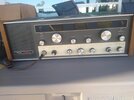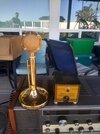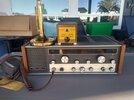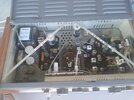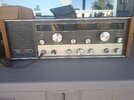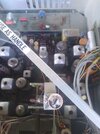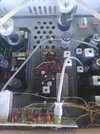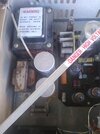Like it says I was fortunate to acquire my father inlaws old Tram D201 that has been boxed up for years. I know better than to plug it in. After several days of searching I came a cross a name of a member of this site that works on this old stuff so thought I would join up and get tuned in if you will and see if Nomadradio will chime in. I can post some photos but thought I would reach out. I hope everyone and a good and safe New Years eve and New Year.
You are using an out of date browser. It may not display this or other websites correctly.
You should upgrade or use an alternative browser.
You should upgrade or use an alternative browser.
-
You can now help support WorldwideDX when you shop on Amazon at no additional cost to you! Simply follow this Shop on Amazon link first and a portion of any purchase is sent to WorldwideDX to help with site costs.
New guy here in search of bring back a Tram D201
- Thread starter Gasngo
- Start date
Welcome to the forum, Nomad usually drops in late in the evening , feel free to post up all the pictures you want.
We enjoy seeing old rigs.
73
Jeff
We enjoy seeing old rigs.
73
Jeff
Thanks for the quick reply I know its holiday time but figured I would post. Need to run to town but Ill get it out in the light and post up some pics. Amazing condition for sure.Welcome to the forum, Nomad usually drops in late in the evening , feel free to post up all the pictures you want.
We enjoy seeing old rigs.
73
Jeff
AmericanEagle575
Supporting Sr. Member WDX-1863
Welcome to the Group and have a upcoming Happy New Year!!Like it says I was fortunate to acquire my father inlaws old Tram D201 that has been boxed up for years. I know better than to plug it in. After several days of searching I came a cross a name of a member of this site that works on this old stuff so thought I would join up and get tuned in if you will and see if Nomadradio will chime in. I can post some photos but thought I would reach out. I hope everyone and a good and safe New Years eve and New Year.
73's
Good news is that it's a 23-channel radio, not a 40.
Bad news is that it's 45-plus years old.
If it was a car that age you would be shopping for every gasket, seal, hose and belt it has.
Just to start.
Access to a tube tester can save a lot of time. The tube sockets tend to wear out in that radio. If you can feel a decent amount of friction when inserting or removing a tube, this is a good sign. A tube that wiggles about loose in the tube socket is trouble. The quality of connection to the tube's pins will come and go. That socket has to go.
A surprising part of the trouble you'll see is from dust, dirt and oxidation on metal-to-metal contact surfaces. Controls, switches, circuit-board plug-in pins, tube sockets and the pins on the tubes all need to be free of any schmoo layer.
The relay bears checking. Easiest test is to tap on the top of it with the radio on the antenna receiving noise or channel chatter. Tapping on the top of the relay should not cause scratch noises. Tapping on the side, as in the side facing the left or right will always produce some 'pop' sound, but not tapping on the top.
Just one problem with this test. Every, single tube socket must be free of scratchy noises first, or you'll hear tube-socket noise when tapping the relay. Crackle noises from tapping the relay only mean anything if you can tap on the surrounding tubes without any noises.
There are three plug-in circuit boards. The header pins where they connect get scrubbed with solvent and a cotton swab until the swab comes away without being darkened. A squirt of solvent into the socket as you plug it in usually cleans up the spring contacts okay. The silver-plated contacts on the channel selector need to have the black tarnish washed off, and a proper "control" cleaner with a light lubricant used to reduce wear on the rotating contact surfaces. A surprising fraction of the faults this model shows you are mechanical in nature.
A list of resistors that need to be changed is around here somewhere. Mileage is a factor. No odometer, but the appearance of 2-Watt carbon resistors on the circuit boards is a clue. Bubbly surface texture, faded color bands indicate high mileage and the odds of a resistor that should be upgraded to the next size up. 2 Watt becomes a 5-Watt, 1-Watt to 2-Watt, and a couple of half-Watt parts get upgraded to 1- or 2-Watt parts.
The electrolytic capacitors must **ALL** go. All of them. No exceptions. The high operating temperature in a D201 prevents them from being reliable at this age. It has a lot of them.
And if the plug-in "BA" board is dark and burned-looking we sell an upgraded replacement on fleabay.
And if it isn't, this suggests low mileage.
Low mileage always works in your favor. High mileage does not.
73
Bad news is that it's 45-plus years old.
If it was a car that age you would be shopping for every gasket, seal, hose and belt it has.
Just to start.
Access to a tube tester can save a lot of time. The tube sockets tend to wear out in that radio. If you can feel a decent amount of friction when inserting or removing a tube, this is a good sign. A tube that wiggles about loose in the tube socket is trouble. The quality of connection to the tube's pins will come and go. That socket has to go.
A surprising part of the trouble you'll see is from dust, dirt and oxidation on metal-to-metal contact surfaces. Controls, switches, circuit-board plug-in pins, tube sockets and the pins on the tubes all need to be free of any schmoo layer.
The relay bears checking. Easiest test is to tap on the top of it with the radio on the antenna receiving noise or channel chatter. Tapping on the top of the relay should not cause scratch noises. Tapping on the side, as in the side facing the left or right will always produce some 'pop' sound, but not tapping on the top.
Just one problem with this test. Every, single tube socket must be free of scratchy noises first, or you'll hear tube-socket noise when tapping the relay. Crackle noises from tapping the relay only mean anything if you can tap on the surrounding tubes without any noises.
There are three plug-in circuit boards. The header pins where they connect get scrubbed with solvent and a cotton swab until the swab comes away without being darkened. A squirt of solvent into the socket as you plug it in usually cleans up the spring contacts okay. The silver-plated contacts on the channel selector need to have the black tarnish washed off, and a proper "control" cleaner with a light lubricant used to reduce wear on the rotating contact surfaces. A surprising fraction of the faults this model shows you are mechanical in nature.
A list of resistors that need to be changed is around here somewhere. Mileage is a factor. No odometer, but the appearance of 2-Watt carbon resistors on the circuit boards is a clue. Bubbly surface texture, faded color bands indicate high mileage and the odds of a resistor that should be upgraded to the next size up. 2 Watt becomes a 5-Watt, 1-Watt to 2-Watt, and a couple of half-Watt parts get upgraded to 1- or 2-Watt parts.
The electrolytic capacitors must **ALL** go. All of them. No exceptions. The high operating temperature in a D201 prevents them from being reliable at this age. It has a lot of them.
And if the plug-in "BA" board is dark and burned-looking we sell an upgraded replacement on fleabay.
And if it isn't, this suggests low mileage.
Low mileage always works in your favor. High mileage does not.
73
Last edited:
Good morning and thanks for the reply and a wealth of info. I have done quite a bit of research and understand the needs for sure. I have not really attempted to push /pull/tug on any components to see what might be loose verses tite. As for millage unknown my wife says her dad got big into the CB thing back in the day then quit. If I had to guess he probably ran it off and on for 5 years or less. From there it sat boxed up in the garage attic. I do have some electronic experience but cleaning controls on vintage stereos and soldering a circuit board on a Mercedes Benz cruise control module are a lot less compared to this thing. I dont have a variac to fire it up so a little hesitant to just plug it in a see where the smoke comes from. So is this something you would want to look at. I see a phone number after searching the web would you ok with a phone call tomorrow.
Thanks Brad
Thanks Brad
Right now I probably have my limit of D201 radios already lined up in the shop. Besides, the only work we solicit right now has to be carried in the door. No shipped-in repairs.So is this something you would want to look at.
Thank you for asking, though.
73
That's a beautiful radio. I'd be tickled to have one of those on the bench. I hope you find someone local, as shipping can be/often is bad on tube rigs, they don't handle those packages tenderly and I have seen\heard of tubes falling out and getting busted during shipping. Id remove the tubes and ship them separately. For cleaning contacts on any slot-edge connectors I use a large eraser or pencil eraser. Thanks for sharing. Good luck.
Good morning and thanks for the reply's. Hand delivery and time are no problem. Its been sitting this long whats another 3/6 months or more. Let me know what you guys think. Not just anybody can make these thing right and I would rather wait for the right person to repair it so I can get a few more years of life out of it. Ill say I enjoy the site a host of good people.


